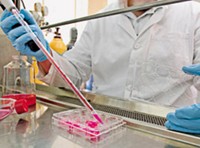Advertisement
Grab your lab coat. Let's get started
Welcome!
Welcome!
Create an account below to get 6 C&EN articles per month, receive newsletters and more - all free.
It seems this is your first time logging in online. Please enter the following information to continue.
As an ACS member you automatically get access to this site. All we need is few more details to create your reading experience.
Not you? Sign in with a different account.
Not you? Sign in with a different account.
ERROR 1
ERROR 1
ERROR 2
ERROR 2
ERROR 2
ERROR 2
ERROR 2
Password and Confirm password must match.
If you have an ACS member number, please enter it here so we can link this account to your membership. (optional)
ERROR 2
ACS values your privacy. By submitting your information, you are gaining access to C&EN and subscribing to our weekly newsletter. We use the information you provide to make your reading experience better, and we will never sell your data to third party members.
Biological Chemistry
Stem Cells
by Rudy Baum
December 3, 2007
| A version of this story appeared in
Volume 85, Issue 49
It is not often that a fundamental scientific advance makes it onto the front pages above the fold of the New York Times and the Washington Post on the same day. Just that occurred two weeks ago with the publication of two papers on techniques to create something very similar to human embryonic stem cells from mature cells without using a human egg or creating an embryo.
The science is undoubtedly exciting. That it received the attention it did, however, owes as much to the intense politicization of stem cell science as to the potential of that science. Moreover, the advances from labs in Wisconsin and Japan do not end the debate over research on embryonic stem cells, as much of the press coverage implied.
The groundbreaking research was conducted by two independent research groups. The group at the University of Wisconsin, Madison, was led by James A. Thomson, who a decade ago isolated the first stem cells from a human embryo. The other at Kyoto University was led by Shinya Yamanaka. A year ago, Yamanaka reported using the method now being applied to human cells in mice to create stem cells. The Wisconsin group published its results in Science (DOI:10.1126/science.1151526), the Japanese group in Cell (DOI:10.1016/j.cell.2007.11.019).
Both used a similar approach, although the details differ. Until now, stem cell clones have been created by a process known as somatic cell nuclear transfer—removing the nucleus of an egg cell and replacing it with the nucleus of a mature cell from the organism being cloned. Something in the cytoplasm of the egg cell effectively reprograms the DNA from the donor cell and allows it to begin development as an embryo.
In the new research, both groups identified four genes responsible for reprogramming mature DNA. Interestingly, they were not the same four genes: Two were the same in both cases, but two were different. Both groups used retroviruses to insert the genes into mature cells. In some small number of cases, this genetic manipulation resulted in the mature cells transforming into cells that behave like embryonic stem cells.
The research is a major breakthrough. It opens up enormous possibilities for studying human disease in ways that would not be possible even if scientists could devise a way to produce embryonic stem cell clones of mature human cells.
The research does not, however, end the need to continue research on human embryonic stem cells, as some commentators immediately asserted. It does not justify the Bush Administration's unyielding opposition to such research. And the claim that Bush's opposition to research on embryonic stem cells somehow drove the current research to its successful conclusion strikes me as ridiculous.
The Times, for example, quotes one Bush adviser as saying, "I don't think there's any doubt that the president's drawing of lines on cloning and embryo use was a positive factor in making this come to fruition."
The Post quotes Richard Doerflinger, of the U.S. Conference of Catholic Bishops, as saying, "This seems to be a way to get all the same uses that embryonic stem cells and cloning might be put to, without the moral problems."
But that is just not so.
These are not embryonic stem cells. They contain four additional genes inserted into their genome randomly by a retroviral vector. In the case of the Japanese work, one of the genes is an oncogene. While incredibly useful for research purposes, it is hard to imagine a situation in which such cells could be used therapeutically. While the researchers suggest that these obstacles will be overcome in time, it is not at all assured that that will be the case.
And promising as the research is, it isn't the only recent breakthrough. A team of scientists at the Oregon National Primate Research Center reported in Nature (DOI:10.1038/nature06357) that they had for the first time created primate embryonic stem cells by somatic cell nuclear transfer. Extending this technique to primates is a major advance.
All such research is important, and none should be blocked or impeded for political reasons.
Thanks for reading.
Views expressed on this page are those of the author and not necessarily those of ACS.



Join the conversation
Contact the reporter
Submit a Letter to the Editor for publication
Engage with us on Twitter